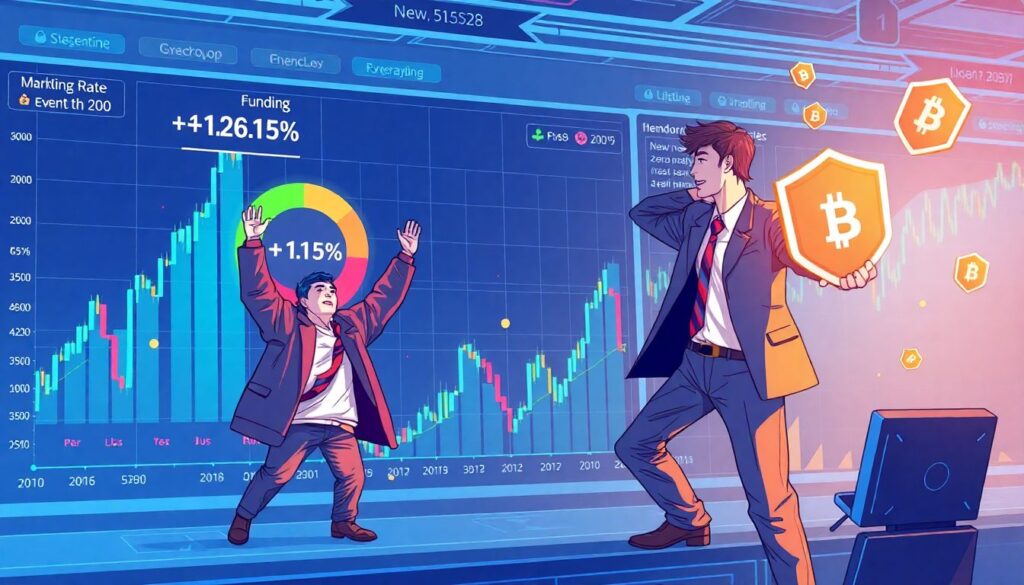“`html
Understanding Funding Rates in High-Volatility Regimes (2025 Update)
“`
The concept of funding rates has taken center stage in crypto and derivatives trading, especially in 2025 as volatility across digital and traditional markets has intensified. For traders navigating perpetual futures, understanding how funding rates behave in high-volatility environments isn’t just a side note—it’s critical for capital preservation and strategy optimization.
In this guide, we’ll break down what funding rates are, why they spike in turbulent markets, and how savvy traders are adapting in today’s increasingly erratic environment.
“`html
What Are Funding Rates and Why Do They Matter?
“`
Funding rates are periodic payments exchanged between long and short traders in perpetual contracts to keep the contract’s price aligned with the spot price. When the market gets out of balance—say, too many longs or shorts—the funding rate shifts to encourage equilibrium.
In low-volatility conditions, these rates often remain near zero. But when markets heat up (as they did in late 2024 and early 2025), rates can swing wildly due to rapid shifts in trader sentiment.
Here’s why it matters:
– High funding rates can erode profits, especially for long positions in bullish frenzies.
– Negative funding rates create opportunities for contrarian plays.
– Understanding funding dynamics helps in timing entries and exits more effectively.
“`html
Key Drivers of Funding Rate Spikes
“`
High-volatility regimes—like what we’re witnessing in 2025 with macroeconomic uncertainty and tighter liquidity—tend to distort funding mechanics. You’ll typically see:
– Sudden surges in long/short positioning
– Liquidity crunches that amplify price dislocations
– Exchange-specific anomalies due to fragmented trader behavior
These factors drive funding rates away from equilibrium and can make leveraged positions unexpectedly expensive.
“`html
How to Trade Around Volatile Funding Rates
“`
The key to thriving in a volatile funding environment isn’t avoiding it—it’s adapting. Below are some battle-tested tactics for 2025’s high-volatility regime.
“`html
1. Monitor Cross-Exchange Differences

“`
Funding rates often differ between exchanges. If one platform shows extreme positive funding while another is neutral, that signals sentiment imbalance. Arbitrageurs can take delta-neutral positions across exchanges to profit from the rate differential.
“`html
2. Use Funding as a Sentiment Indicator

“`
Funding rates are a proxy for market bias. If funding hits +0.15% every 8 hours, the market is clearly euphoric. Traders can fade the crowd by shorting into these extremes—just manage risk tightly.
“`html
3. Hedge Spot Exposure When Funding Is Unfavorable
“`
If you’re long spot and futures funding becomes too punitive, consider hedging with inverse perpetuals or short-dated options rather than closing your position outright. This reduces exposure to fees without abandoning the trade thesis.
“`html
4. Trade During Funding Rate Transition Windows

“`
Funding payments usually occur every 8 hours. Minutes before the timestamp, you’ll often observe erratic moves as traders open or close positions to avoid rate costs. These windows can offer precise scalping opportunities—with low exposure.
“`html
5. Automate Funding Rate Arbitrage
“`
For systematic traders, integrating real-time funding data into bots can uncover cross-market inefficiencies. In 2025, API access and latency-sensitive execution are baseline requirements for competing in this niche.
“`html
Risks of Chasing Volatile Funding
“`
While funding rate strategies can be lucrative, they’re not risk-free:
– Sudden price reversion: Shorting euphoric long markets can backfire if trend continuation overwhelms funding decay.
– Exchange risk: Over-concentrating on one venue increases exposure to technical issues or liquidation cascades.
– Regulatory shifts: Some platforms have adjusted funding mechanisms due to policy crackdowns. Stay updated or risk trading outdated models.
“`html
Looking Ahead: How Funding Rates Might Evolve
“`
In 2025, funding rates are no longer a secondary concern—they’re a core part of strategy design. As institutional volume pours into crypto and volatility remains high from geopolitical tremors, we expect funding rate mechanics to evolve in the following ways:
1. More adaptive funding algorithms: Exchanges may shift to real-time or dynamic funding models (instead of fixed intervals) to prevent manipulation.
2. Layer-2 arbitrage expansion: Faster execution on L2 networks like Arbitrum and zkSync will fuel new funding arbitrage strategies.
3. Integration into risk dashboards: Retail apps and pro platforms will incorporate funding rate forecasts to help users anticipate fee impacts before placing trades.
4. Tighter regulation: In some jurisdictions, authorities may mandate clearer funding disclosures, especially for leveraged products.
“`html
Final Thoughts
“`
Funding rates aren’t just a technical detail—they’re an insight into how the crowd is positioned and a cost structure that can make or break trades. In today’s high-volatility regime, ignoring them is like trading blindfolded. Whether you’re a scalper, swing trader, or portfolio manager, treat funding rates as a strategic input—not a footnote.
Stay nimble, exploit inefficiencies, and above all—respect the cost of leverage.
Welcome to the funding wars of 2025.

